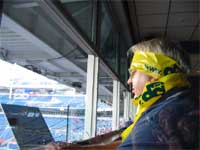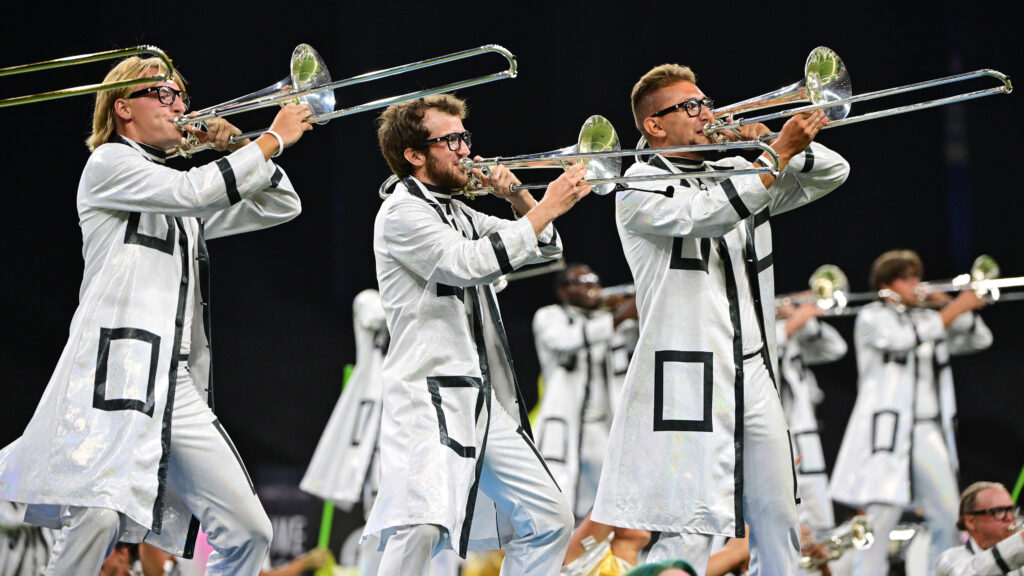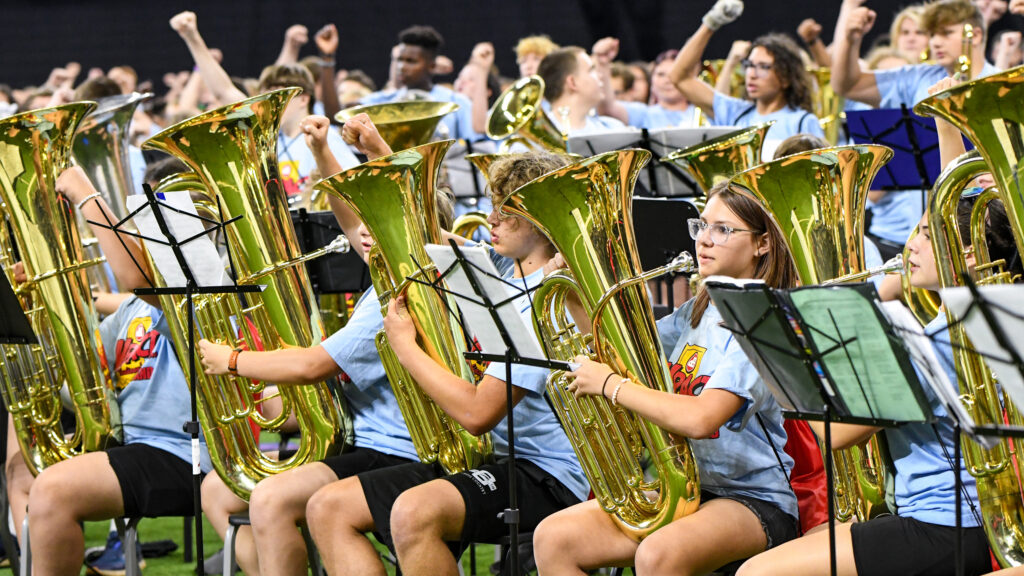Geoffrey C. Whiting was a member of the Auburn Purple Lancers in 1974, the year the corps made DCI World finals. This year is the 30th anniversary of that feat.

The year was 1974. Drum Corps International was in its third year and had rapidly become the drum corps world’s most prestigious championship, displacing the American Legion, V.F.W., World Open, and U.S. Open. New York State had yet to leave a mark on DCI. Mighty St. Joe’s of Batavia, the perennial state American Legion champs and national finalist, had disbanded after the 1971 season and the New York City corps never joined DCI. This left a power void nationally for the “Empire State.” By 1974, the time was ripe for a national-caliber corps to emerge from this fertile land of mostly small community drum corps. I became a drum corps fan in 1965 when I started playing the cornet in junior high school. I was completely captivated by the passion of drum corps performances. The local high school band performances, which had first awakened my interest in instrumental music, paled in comparison to this exciting type of musical genre that made every note sound so important! I did not have to travel far to see my first show, a 15-minute walk from my house to my high school football field. In the mid-1960s in upstate New York, virtually every other town had a drum corps. Interstate 90, the east-west highway running from Buffalo to Albany, was the main artery of drum corps in upstate New York. I joined the Geneva Appleknockers junior corps in the fall of that year and fell in love with the activity, marching with them from 1966 through 1973. The Auburn Purple Lancers were our fierce competitors 15 miles to the east. We dominated them most of that time. In 1967 they even merged with a corps to our west, the Shortsville Shamrocks, in an attempt to encircle and beat us! They dubbed themselves “The Dynamic Duo” (Batman was a popular TV show of the day). A very nice try, but we prevailed. However, starting in 1972, the Purple Lancers began to come on as an emerging state powerhouse, wearing new uniforms that were oddly reminiscent of St. Joe’s, but at the purple end of the spectrum. By 1974, Purple Lancers was the New York State junior corps that found itself with the organization and momentum to put together a national caliber corps. This corps was attracting the attention of a region of seasoned — but unfulfilled — drum corps members. And so, I found myself embracing the emerging juggernaut in the hope of marching in a national caliber drum corps during my age-out season. We were a regional drum corps comprised of many local corps members (St. Joe’s, Appleknockers, Syracuse Marauders, and many more) added to the solid Auburn core. With a strong 54-person horn line, six snares and four tri-toms drum line with marching keyboards, and a large and talented guard, the raw materials were there. There was a sweet anticipation as the corps came together during the winter. This was going to be the best drum corps in which most of us had ever marched! Our program picked up on the lead of the standard setter of the day, Santa Clara Vanguard. The symphonic sound we adopted was certainly a different style of music than most of us were used to playing in corps and much, much more difficult. The music included the final movement of “Divergents” by W. Francis McBeth, “Suite of Old American Dances” by Robert Bennett, and “La Fiesta Mexicana” by Owen Reed. The show was written by Corky Fabrizio (horn arranger), Bill Decker (percussion arranger) and Phil Cerimelli (drill writer). I will never forget my first winter rehearsal with them — desperately trying to coordinate valve, rotor, and feet while searching for the one note on the downbeat in the “Rag” movement from the suite. Getting out of step made this drum corps veteran realize that this season of DCI competition was going to be a different animal! That spring found the corps feverishly trying to coordinate drill and music. In the early days of DCI, there was much less stop time playing. If you weren’t marching, you were marking time. Most of the stop time was concentrated in the “concert” portion of the show, which was usually positioned in about the middle of the 11- to 14-minute performance. We had such a difficult time getting “Divergents” to unfold right that we did not get past this opening number until early June. We then raced through learning the rest of the show in order to make the deadline for our first performance June 21 in exhibition at our home show in Auburn. The presentation of somewhat obscure “musicians” music, for the first time in my drum corps experience, was preeminent over simply executing popular and familiar tunes well. Well, we quickly realized that our plan for DCI success was in jeopardy when we beheld Madison’s performance at our show. Sixty-four buglers wailing on what was not only familiar and toe-tapping music, some of which had already been done well by other corps (i.e.: “Slaughter on 10th Avenue”), but was being taken now to a new level. They played the old-time drum corps formula for crowd entertainment to perfection. Beautiful backfield sounds counterpointed with a fearsome tempestuous rage as they came toward the stands, climaxing the music with a resounding high mark time. It resonated the very bones of the spectators! How were we going to compete against that with the cerebral strains of our suite? The irony of that show was that Madison was actually edged out by the Hawthorne Muchachos in what was to be one of their few losses that season. It was also a statement that the “East was back” to contest the highest echelons of drum corps success. This was something that the East, the cradle of championship drum corps, was smarting from in the first two years of DCI — years that had been dominated by the West and Midwest. The next week we were launched on our competitive season as we set out on a grueling 18-hour trip to Dubuque, Iowa in 90-degree humidity in buses without air conditioning! Over the next week we competed in Iowa and Wisconsin against some of the Midwest and East’s finest corps. We found ourselves looking up at a yawning 10-12 point gap from Madison, fearing there were at least 11 other corps who would fill that, leaving us on the outside during DCI World finals. Closer to us were corps like Blue Stars, Phantom Regiment, Kilties, 27th Lancers, Garfield (The Cadets), and The Cavaliers. There was a seeming multitude of corps vying for the elite top twelve. I can remember marching off past The Cavaliers at retreat and getting an earful of their discouraged staff threatening to fold the corps if they could not do better! If we were to emerge from this multitude of potential finalists, the performance of our drill needed work. There was also the conundrum created by the musical style and difficulty of our pieces that diminished our GE scores. We often wished that we could be judged in a semicircle. We returned to New York for the abbreviated conventional portion of the New York State drum corps season for a show in Utica, going on to garner the state American Legion championship. By this time, we had little competition from the other corps in the state. Choosing to seek the DCI top 12 had already made us into a different type of drum corps from our members’ root experiences. We were no longer local and were distancing ourselves from community support. We had abandoned the regional circuits and set our goals beyond the state American Legion. We were marching a schedule that made it very difficult to work a summer job, as had been the norm for corps members when drum corps competition was a weekend activity. We were performing music and marching a show that was very difficult for an individual with a limited musical and marching background to master. For the next couple weeks, we yo-yoed from Massachusetts to Kentucky. The hard work on our drill was paying off as we finally closed the gap on Phantom Regiment and eventually Blue Stars, but we were having trouble solidifying our hold on number two in the East. At World Open we traded victories with Garfield, Bridgemen and the Pembroke Imperials while the Muchachos had a solid hold on the number one spot in the East the entire season. The Boston rehearsals around the CYO Championships were an important final tune-up for us going into the DCI Championships. DCI that year was held in the beautiful natural setting of Ithaca, N.Y. at Cornell University. For us in the Purple Lancers this was like a home show, since Auburn was a mere 38 miles from Ithaca. This was the first time that the DCI Championships had been held outside the Midwest. There was eager anticipation and hope for a return of Eastern respectability. The Muchachos and Purple Lancers were the darlings of the crowd as we were spurred on by chants of “East, East, East.” Jeff Kievit led the Muchachos on the field like a veritable toreador with his commanding solo work on soprano. Preliminaries were delayed by a cloudburst just prior to our performance. The anticipation was excruciating as we waited under the stands for the rain to stop. The field was well-drained turf, but I can still remember the sensation of marching on a wet sponge! The preliminary performance was on for us and propelled us to a tenth-place finish and finalist status. This still represents the only finalist placing for a New York State drum corps in DCI’s 32 years. I remember nothing of the short bus ride back to Auburn after the DCI finals. The moment I hit the seat I was off into the satisfied slumber of drum corps accomplishment and the dreams of a crowning achievement to my days of competition.
Michael Boo has been involved with drum and bugle corps since 1975, when he marched his first of three seasons with the Cavaliers.
He has a bachelor’s degree in music education and a master’s degree in music theory and composition.
He has written about the drum corps activity for over a quarter century for publications such as Drum Corps World, and presently is involved in a variety of projects for Drum Corps International, including souvenir program books, CD liner notes, DCI Update and Web articles, and other endeavors. Michael currently writes music for a variety of idioms, is a church handbell and vocal choir director, an assistant director of a community band, and a licensed Realtor in the state of Indiana. His other writing projects are for numerous publications, and he has published an honors-winning book on the history of figure skating. His hobbies include TaeKwonDo and hiking the Indiana Dunes. But more than anything, Michael is proud to love drum corps and to be a part of the activity in some small way, chronicling various facets of each season for the enjoyment of others.





